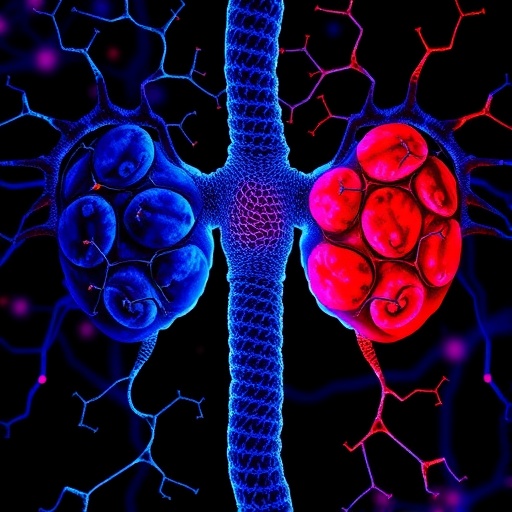Recent studies have illuminated the intricate relationship between reactive oxygen species (ROS) and ovarian damage induced by the chemotherapy drug cyclophosphamide. This research, spearheaded by Camp, O.G., Abu-Soud, H.M., and Biernat, M.M., offers an updated perspective on the mechanisms of oxidative stress and how it underlies the pathophysiology of gynecological health issues linked to cancer treatments. Understanding these connections is pivotal in advancing therapeutic strategies that mitigate the adverse side effects of cancer medications.
Each year, countless women confront the reality of cancer therapies that come with debilitating side effects, particularly when it comes to reproductive health. Cycles of chemotherapy have been associated with increased levels of oxidative stress, which can compromise ovarian functionality and alter fertility. As the study unfolds, it sets the stage for a deeper exploration of how ROS interact with ovarian tissues and cells during treatment.
Cyclophosphamide, a cornerstone of many chemotherapy regimens, has been implicated not only in tumor regression but also in the induction of ROS. This creates a paradox whereby a treatment aimed at eliminating cancerous cells unwittingly contributes to reproductive complications. The research explores the molecular pathways through which ROS can instigate cellular damage, including lipid peroxidation, DNA fragmentation, and the induction of apoptosis within ovarian follicles.
Furthermore, this study draws attention to the critical role that antioxidants may play in mitigating such damage. Compounds that can neutralize reactive oxygen species show promise as potential protectants, highlighting the significance of cellular redox status in maintaining ovarian health. Early findings suggest that pre-treatment with specific antioxidants can alleviate the adverse effects of cyclophosphamide, restoring normal ovarian function and improving fertility outcomes in affected patients.
The implications of this research extend beyond individual experiences; they resonate throughout the field of oncology. As fertility preservation gains increased visibility among cancer patients, understanding the molecular interactions between chemotherapy agents and reproductive tissues becomes essential. This work lays the groundwork for future clinical interventions aiming to safeguard women’s reproductive potential while still delivering effective cancer treatment.
Interestingly, the research integrates a variety of experimental models, from in vitro studies to animal models, which are crucial for elucidating the multifaceted impact of CYP on ovarian health. By employing state-of-the-art methodologies, the authors have been able to quantify ROS levels and assess their damaging effects on ovarian cellular integrity. These innovative approaches pave the way for enhanced reproducibility and reliability in findings that could ultimately shape future clinical guidelines.
Additionally, the study meticulously reviews existing literature surrounding ROS and cyclophosphamide, compiling a comprehensive dataset that enhances the current understanding of this complex interaction. The synthesis of data from various studies promotes a clearer picture of how ROS contribute to ovarian dysfunction, thereby fostering a more informed approach to patient care during chemotherapy.
With these findings, there’s a hopeful outlook for the future of cancer treatment. The idea of combining traditional chemotherapy with antioxidant therapies could significantly alter the narrative for reproductive health among cancer survivors. Future research will undoubtedly seek to clarify which antioxidant compounds are most effective and at what dosage they should be administered.
The research efforts shared by Camp et al. open a vital dialogue about the need for integrative approaches in oncology that prioritize not just survival rates but also the quality of life and reproductive autonomy of women post-treatment. Trends in personalized medicine could leverage these insights to offer tailored therapies, minimizing damage while maximizing efficacy.
Furthermore, this investigation underscores the essential role of multidisciplinary cooperation in scientific advancement. Collaboration between oncologists, reproductive specialists, and molecular biologists will be crucial for translating these findings into clinical practice. Ensuring that oncological approaches are not only effective against cancer but also cognizant of their full spectrum of effects on patients is a noble goal, one that this research bravely tackles.
The urgency behind this research cannot be overstated, as the rising number of young women diagnosed with cancers calls for solutions that respect their reproductive future. Women deserve treatment strategies that consider their unique life stages and aspirations and that strive to minimize the burdensome side effects long after the chemotherapy cycles conclude.
As we dive deeper into the mechanics of cyclophosphamide and its role in generating reactive oxygen species, it becomes clear that pioneering studies like this one are paramount. They illuminate pathways not just for preservation but for enhancement of quality of life in cancer survivors, showing the profound impact that targeted therapies can have on their futures.
Research such as that led by Camp, Abu-Soud, and Biernat resonates with the scientific community, prompting further inquiry and advocacy for better treatment protocols in female oncology. As we gather more data and context, there lies a promise of clearer guidelines that can be integrated into routine patient care, ultimately ushering in an era where the conversation about fertility and health post-cancer becomes integral to treatment planning.
In conclusion, the dynamic interplay between reactive oxygen species and cyclophosphamide-induced ovarian damage encapsulates a transformative exploration in oncological research. It calls for sustained efforts towards not only understanding these biochemical interactions but also leveraging that knowledge into actionable treatment solutions that honor the complexities of women’s health in the fight against cancer.
Subject of Research: Reactive Oxygen Species and Cyclophosphamide-Induced Ovarian Damage
Article Title: An updated look into reactive oxygen species and cyclophosphamide-induced ovarian damage
Article References: Camp, O.G., Abu-Soud, H.M., Biernat, M.M. et al. An updated look into reactive oxygen species and cyclophosphamide-induced ovarian damage. J Ovarian Res 18, 285 (2025). https://doi.org/10.1186/s13048-025-01849-2
Image Credits: AI Generated
DOI: https://doi.org/10.1186/s13048-025-01849-2
Keywords: Reactive Oxygen Species, Cyclophosphamide, Ovarian Damage, Chemotherapy, Antioxidants, Reproductive Health, Oncology, Fertility Preservation, Women’s Health




